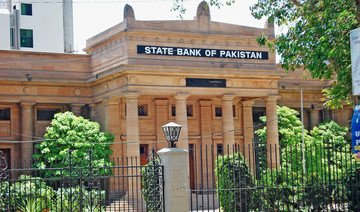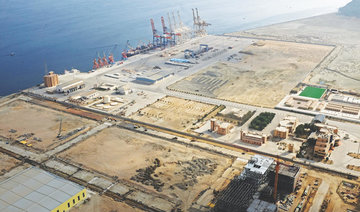ISLAMABAD: Pakistan expects to obtain fresh Chinese loans worth $1-2 billion to help it avert a balance of payments crisis, Pakistani government sources said, in another sign of Islamabad’s growing reliance on Beijing for financial support.
Lending to Pakistan by China and its banks is on track to hit $5 billion in the fiscal year ending in June, according to recent disclosures by officials and Pakistan finance ministry data reviewed by Reuters.
The ramp up in China’s lending comes as the United States is cutting aid to Pakistan following a fracture in relations between the on-off allies. In February, Washington led efforts that saw Pakistan placed on a global terror financing watchlist, drawing anger in Islamabad amid fears it will hurt the economy.
The new Chinese loans that are being negotiated will help bolster Pakistan’s rapidly-depleting foreign currency reserves, which tumbled to $10.3 billion last week from $16.4 billion in May 2017.
The talks come only weeks after a group of Chinese commercial banks lent $1 billion to Pakistan’s government in April.
The reserves decline and a sharp widening of Pakistan’s current account deficit have prompted many financial analysts to predict that after the general election, likely in July, Islamabad will need its second International Monetary Fund (IMF) bailout since 2013. The last IMF assistance package was worth $6.7 billion.
Beijing’s attempts to prop up Pakistan’s economy follow a deepening in political and military ties in the wake of China’s pledge to fund badly-needed power and road infrastructure as part of the $57 billion China-Pakistan Economic Corridor (CPEC), a key cog in Beijing’s vast Belt and Road initiative.
“I think this month we will get that $1-2 billion,” said a senior Pakistan government official, saying the funds will come from Chinese state-run institutions.
A second government official confirmed Pakistan was in “sensitive” talks with Beijing over extra funding for up to $2 billion.
Pakistan finance ministry officials did not respond to a request for comment.
China’s finance ministry and central bank, who were faxed questions about the loans, did not immediately respond to requests for comment.
Although Pakistan’s economic growth has soared to nearly 6 percent, the fastest pace in 13 years, the structural problems with the economy are coming to the fore. It is similar to 2013, when foreign currency reserves dwindled and Pakistan narrowly escaped a full-blown currency crisis.
“The current situation appears to be a replica of what we experienced in 2013, albeit on a slightly larger scale,” said Yaseen Anwar, who was the governor of the central bank, the State Bank of Pakistan (SBP), back in 2013.
The darkening macroeconomic outlook prompted the IMF earlier this month to downgrade its economic growth forecast for Pakistan to 4.7 percent for the next fiscal year ending in June 2019, way below the government’s own ambitious target of 6.2 percent.
“TEMPORARY BRIDGE“
Over the past nine months Pakistan has enacted a series of measures to combat its ballooning current account deficit, including hiking tariffs on more than 200 luxury items and devaluing its currency by about 10 percent.
In the six months to end of March, Pakistan took bilateral loans worth $1.2 billion from China, according to the Pakistan Finance Ministry document reviewed by Reuters. During this period the government also borrowed about $1.7 billion in commercial loans, mostly from Chinese banks, finance ministry officials added.
In April, Pakistan’s central bank borrowed another $1 billion from Chinese commercial banks to buffer its reserves, State Bank of Pakistan Governor Tariq Bajwa told the Financial Times (FT). A spokesman for the central bank told Reuters the FT report was accurate.
The $1-2 billion under discussion would be in addition to that loan.
So far, all the measures appear to have had a limited impact on Pakistan’s economy and foreign exchange reserves continue to plummet.
The collapse of the reserves is mainly due to the central bank’s efforts to maintain an artificially strong rupee over the past few years, analysts say. The currency is now trading at about 115.50/116 to the US dollar, down 9.8 percent in last six months after two separate devaluations since December.
In the past three weeks, reserves have declined by $1.2 billion and now stand at two months worth of import cover.
“This new (Chinese) money is a temporary bridge until August or September, when a new government will come into office and the country will likely opt for a new IMF program,” said Saad Hashmey, chief economist at brokerage house Topline Securities.
Hashmey and several other economists are predicting another currency devaluation by the end of 2018.
Pakistan may also seek help from Saudi Arabia. The Middle Eastern ally loaned $1.5 billion to Pakistan in 2014 to shore up its foreign currency reserves.
RISING EXPORTS
The scale of the task facing Pakistan is huge as the current account deficit widened to $14 billion in the first 10 months of the current fiscal year, according to SBP data. Dollar-denominated debt repayments in 2018 are also expected to top $5 billion, analysts say.
Part of the problem for Pakistan has been a multi-year consumer boom accompanied by huge imports of Chinese machinery for CPEC projects, which has piled pressure on the current account deficit. More recently, a jump in the oil price has compounded the problem as Pakistan is a fuel importer.
One of the senior Pakistani government officials said the money from China should give the economy breathing space.
He said exports have shot up in the last two months, helped by the devaluation in the rupee, and that should help ease the current account deficit.
However, Pakistan’s central bank appears more nervous as oil prices climb, raising its main policy rate by 50 basis point to 6.5 percent on Friday and warning the “the balance-of-payments picture...has further deteriorated.”
Pakistan seeks economic lifeline with fresh China loans
Pakistan seeks economic lifeline with fresh China loans
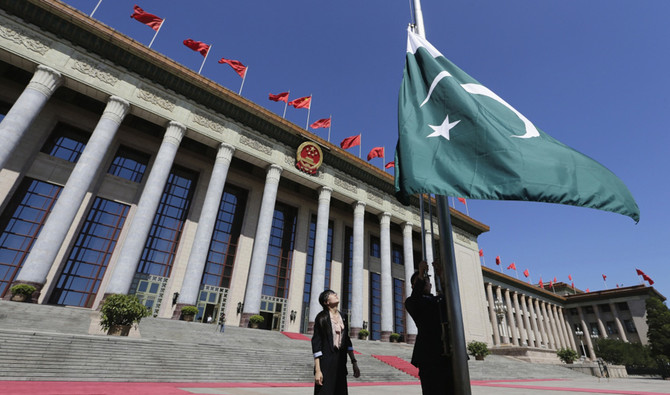
- China now Pakistan’s biggest investor, debt inflows grow
- Pakistan received $6.7 bln IMF bailout in 2013
Saudi government assets to remain strong through 2030: S&P Global

RIYADH: The Saudi government’s assets are forecasted to remain strong amid steady economic diversification efforts aimed at reducing the Kingdom’s dependence on oil, stated a new report.
According to S&P Global, the increasing debt issuance to fund Vision 2030 projects may exert pressure on Saudi Arabia’s net asset position until the end of the decade. However, the Kingdom will mitigate this impact through its wise and prudent fiscal policies.
“S&P Global Ratings expects that growing debt issuance to finance Vision 2030 projects could pressure the sovereign’s fiscal metrics. In our base case, however, we expect the government’s net asset position will deteriorate but remain strong,” stated the credit-rating agency.
It added: “The ramp-up in fiscal deficits and debt could weaken the government’s balance sheet far sooner than returns on investment will accrue. Much will depend on the roles that foreign investment, the private sector, and capital markets will play in financing Vision 2030.”
According to the report, Saudi Arabia’s sovereign wealth fund, spearheading the Kingdom’s economic diversification efforts, aims to invest $40 billion annually in the local economy to bolster Vision 2030 goals.
The US-based firm highlighted that the Saudi government will continue to support the Public Investment Fund in various ways, including funding essential infrastructure for mega and giga project sites.
Domestic banks to play key role
Furthermore, S&P Global added that the Saudi government and PIF will try to boost external funding and diversify the investor base to mitigate the impact on domestic banks’ liquidity.
“We expect domestic banks will still play a key role in funding the public and corporate sectors, given the large size of projects. Domestic banks will likely see a shift from mortgage lending toward corporate lending and Vision 2030 project funding,” noted the credit rating agency.
However, the report added that the Kingdom’s banking system alone cannot accommodate all the financing needs associated with Vision 2030.
Banks in Saudi Arabia will use alternative strategies, such as raising additional external funding, to meet the increasing credit demand.
“In 2023, Saudi banks injected almost $55 billion in the form of investments and financing in the public and corporate sectors, excluding financing to the retail sector. In 2024, we expect banks will grow their lending book by 8 percent to 9 percent,” said S&P Global.
It added: “Under the assumption that 70 percent of that lending is for corporates, banks can inject $40 billion to $44 billion in financing. A portion of that could be used in Vision 2030.”
The report projected an approximate 8 percent increase in deposits for 2024, with external debt issuance expected to reach around $10 billion to facilitate anticipated lending growth.
Earlier this month, another analysis by the agency underscored the robust condition of the Saudi banking sector, highlighting strong asset-quality indicators and overall capitalization.
S&P Global further noted its expectation for banks’ solid profitability and conservative dividend payouts to sustain their capitalization over the next one-to-two years.
The report also noted that Saudi banks have already accessed international capital markets, a trend the credit-rating agency expects to persist for the next three to five years.
Furthermore, the Saudi government and its related entities are anticipated to inject deposits into the banking system, thereby bolstering the credit growth of financial institutions in the Kingdom.
Public and private investment
S&P Global also predicted that certain Vision 2030 projects will extend beyond this decade, facilitating a more organic increase in economic activity and foreign investment.
While PIF and the government will persist in debt-financed investment for Vision 2030, other government-related entities, including portfolio companies of the wealth fund, private-sector participants, and foreign direct investment, will also play crucial roles in implementing economic diversification projects in the Kingdom.
The report underscored that FDI inflows have averaged around 2 percent of Saudi Arabia’s gross domestic product over the past three years, with the Kingdom aiming to increase this to 5.7 percent by 2030.
According to S&P Global, the opening of free economic zones and the regional headquarters program could expedite the growth of FDI inflows in the coming years.
“Future FDI inflows could offer upside on the back of growing investment opportunities and government efforts to improve regulatory and business conditions. These efforts include the opening of free economic zones and a 30-year tax break for multinational companies opening regional headquarters in the country,” added the agency.
It underscored the role of the Saudi capital market in catalyzing the Kingdom’s economic diversification efforts.
The report highlighted that the Saudi exchange is collaborating closely with the Capital Markets Authority to streamline processes and attract both local and international issuers by enhancing market functionality and efficiency.
These initiatives by Tadawul will ultimately enhance the appeal of debt and equity transactions on capital markets and facilitate a more diversified funding base for Vision 2030 projects.
It also noted that the Saudi government possesses additional assets it could leverage to support Vision 2030 and prevent an expanding debt bubble. This includes an 82 percent stake in Saudi Aramco, which boasts a market capitalization exceeding $7 trillion.
“The government has thus far transferred a total 16 percent stake in Saudi Aramco to the PIF and its subsidiaries, which has substantially added to the PIF’s asset base, leading to dividend returns that it can deploy toward Vision 2030 projects. The government could choose to sell further stakes in Aramco through an IPO (initial public offering) to raise additional financing,” added the agency.
Pakistan’s benchmark share index rises as much as 1.5%
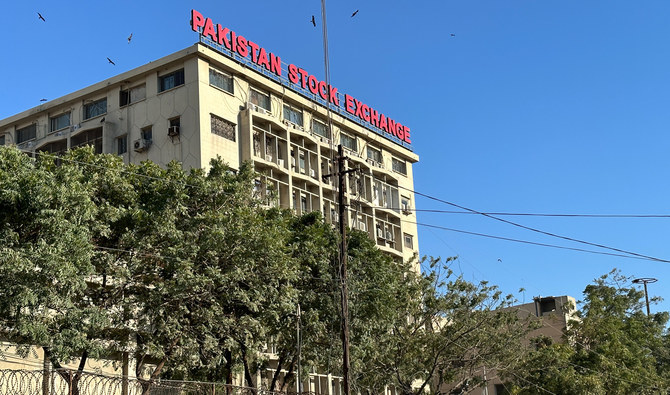
- Pakistan’s benchmark share index has surged 73.4% over the past year, up 12.9% year-to-date
- Market reacting to Saudi business delegation’s arrival, IMF statement on mission visit, says analyst
KARACHI: Pakistan’s benchmark share index rose 1.5% during intraday trade on Monday, to an intraday high of 72,986 points.
The index has surged 73.4% over the past year and is up 12.9% year-to-date.
A Saudi delegation arrived in Pakistan on Sunday for talks on trade and investment opportunities, particularly in the exploration and production sectors.
Adnan Sheikh, assistant vice president at Pak Kuwait Investment Company, said the market was up following news of the delegation’s arrival along with an IMF statement regarding a mission visit.
“The PSX is still very cheap with price to earnings ratio of under 5x compared to average of 8x,” Sheikh added.
Pakistan last month completed a short-term $3 billion program, which helped stave off sovereign default, but the government of Prime Minister Shehbaz Sharif has stressed the need for a new longer term program.
An International Monetary Fund mission is expected to visit Pakistan this month to discuss a program, the lender said on Sunday ahead of Islamabad beginning its annual budget-making process for the next financial year.
The IMF did not specify the dates of the visit, nor the size or duration of the program.
Earlier, in an interview with Reuters, Finance Minister Muhammad Aurangzeb said the country hoped to agree the outlines of a new IMF loan in May.
Pakistan is expected to seek at least $6 billion and request additional financing from the Fund under the Resilience and Sustainability Trust.
Saudi Rasan to offer 30% shares for IPO on Tadawul

RIYADH: Saudi-based fintech Rasan Information Technology Co. is set to offer 22.74 million shares for an initial public offering on the Kingdom’s main market.
The company, along with its subsidiaries, will list the shares, which represent 30 percent of its issued share capital, on Tadawul through the sale of 17.4 million existing ordinary shares as well as 5.3 million new ordinary shares, according to a statement.
While the existing ordinary shares account for 23 percent of the company’s issued share capital, the new ordinary shares represent 7 percent.
This comes following the Capital Market Authority’s approval in March of the fintech firm’s application for registering its share capital and offering the total number of ordinary shares, with a nominal value of SR1 ($0.27) per share.
Moreover, the offering proceeds after deducting IPO-related expenses will be distributed to the selling shareholders equally based on their shareholding in the existing ordinary shares.
The remaining proceeds are set to be distributed to the company in order to expand its current operations and products, market and develop new products, as well as finance the general purposes of the firm and its subsidiaries.
The final price of the offer shares, which account for the existing and new ordinary shares combined, will be determined by the existing shareholding and the company, in consultation with the financial advisers, following the book-building process and prior to commencement of the subscription period for individual subscribers.
The financial advisers include Saudi Fransi Capital and Morgan Stanley Saudi Arabia.
Saudi Aramco raises June’s Arab light crude price to Asia

RIYADH: Saudi Aramco raised June’s official selling price for the flagship Arab light crude it sells to Asia, according to an official statement.
Differentials for the flagship Arab Light grade were priced at Platts Dubai/DME Oman +$2.90 per barrel, up from +$2 a barrel in April.
This was the highest OSP in five months and largely in line with expectations, based on a firmer market structure and higher spot premiums last month for tradable Middle East grades such as Oman, Al Shaheen and Upper Zakum.
The higher OSPs also came after the Organization of the Petroleum Exporting Countries and its allies, known as OPEC+, maintained the first quarter round of voluntary cuts into the second quarter, while the global crunch on supplies of sour crude also underpinned Middle East grades.
Arab Medium was increased by $1 per barrel to +$2.35 per barrel, while Arab Heavy was hiked $1.10 a barrel to +$1.60 per barrel.
For Northwest Europe, the Arab Light OSP was set +$2.10 per barrel over ICE Brent futures, up from +$0.30/b while Medium was hiked from minus $0.40/b to +$1.10/b. Both grades were hiked to reflect the relative weakness in Brent compared to sour barrels.
Arab Light for April to the US Gulf was kept unchanged at +$4.75 per barrel over ASCI, while Medium was at +$5.45/b and Heavy at +$5.10/b, respectively, both slightly lower on the month.
Hong Kong, Chinese investors set eyes on Saudi market
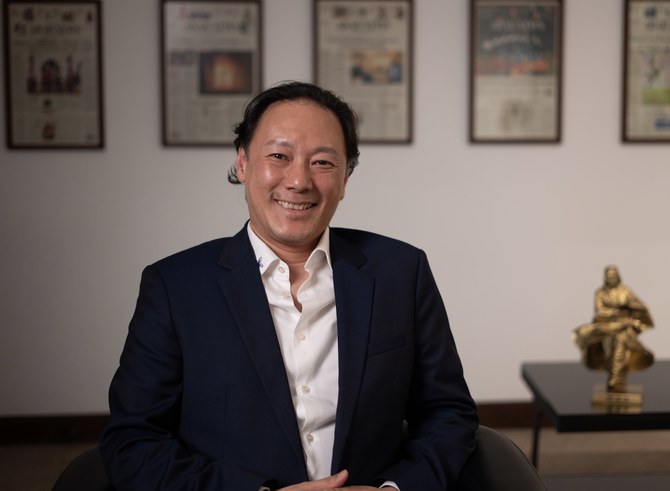
- A delegation of business leaders is set to explore diverse sectors in the Kingdom
RIYADH: Hong Kong and Chinese companies are gearing up for substantial investments in the Saudi market, marking a significant step toward strengthening economic ties, a top official said.
A delegation of 30 business leaders from Hong Kong and mainland China is set to explore diverse sectors in the Kingdom, propelled by the ambitious Vision 2030 outlined by Saudi leadership, King Leung, global head of financial services and fintech at Invest Hong Kong, said in an interview with Arab News.
Explaining the reason for his visit to Riyadh, Leung said: “I’m bringing a delegation of 30-plus executives across different disciplines to explore ways to do business in Saudi Arabia. This is not just about attracting inbound (investment), but also helping mainland Chinese companies use Hong Kong as a base to springboard to key markets like Saudi Arabia.”
Outlining the potential for co-investment between the two nations, he said: “Definitely, it’s going to be a huge number,” a sentiment that echoes the palpable excitement among Hong Kong investors who are eager to tap into the vast opportunities offered by the Saudi market.
The convergence of interests between Hong Kong and Saudi Arabia is underpinned by a notable synergy observed between businesses in both regions, the executive said, with an eye on forging strategic partnerships.
Hong Kong delegates, including private sector leaders and venture capitalists, are eager to explore avenues for collaboration that align with the objectives of Vision 2030.
“All these things that we are now finding out allow business leaders to see that some businesses from Hong Kong actually have very, very good synergy with Vision 2030 in your country.”
“It’s hard to quantify the exact number, but definitely, it’s going to be (a) huge number. I have to say these investments cut across different sectors, where you can imagine the market size is enormous,” he said, emphasizing the allure of megaprojects such as NEOM and the King Salman Park, which are set to transform the Saudi investment landscape.
These projects not only serve as magnets for investment but also catalyze growth in ancillary sectors such as financial services and consumer products, the head of financial services emphasized.
“These are megaprojects. So, all these things are going to really attract a lot of business activities, of course, initially in construction. But once you have all this construction coming in, then you need the other peripheral sectors to service them, like financial services, consumer products, and payments. So, all these things present a lot of opportunities that really get our delegates and investors from Hong Kong and China very excited,” he further explained.
Another testament to the nation’s favorable investment ecosystem is its “impressive GDP growth and low debt ratio,” factors that instill confidence among investors.
Among the sectors garnering attention are green energy and advanced manufacturing, the delegate said, affirming that Saudi Arabia is “paving the way for the future” of clean energy.
Hong Kong-based companies, armed with cutting-edge technologies, are eyeing opportunities to contribute to Saudi Arabia’s sustainable development goals.
“I understand that your country is also paving the way for the future, including adopting green energy now. So, one green energy company that I have been talking to in mainland China, they have been in the green hydrogen space for some time, and they are evaluating to put a green hydrogen factory in Saudi Arabia.”
Thus, projects such as the green hydrogen factory, poised to harness solar power for hydrogen production, exemplify this collaborative spirit.
“Now, of course, the reason why they’ve done that, part of it, is because the way they generate hydrogen is to use solar power. So they need to go to a place where this is something in abundance. Now, at the same time, you also have some highly visionary, highly capable investment vehicles from the PIF and other funds,” he noted.
Furthermore, the burgeoning fintech ecosystem in Saudi Arabia presents fertile ground for collaboration between Hong Kong and the Kingdom.
Fintech companies from Hong Kong are eager to leverage their expertise to enhance banking services and drive digital transformation initiatives in the Kingdom, the executive noted, adding, “In our delegation, we have roughly, I’ll say between 10 to a dozen or so fintech companies that are very keen to see if they can bring the business and set up in Saudi Arabia so that they’re able to service the banks here.”
On the opposite end, recognizing the potential for synergy, banks from Saudi Arabia are contemplating establishing a presence in Hong Kong to bolster their trade and financial services, he said.
This strategic move aims to capitalize on Hong Kong’s strategic position as a gateway to the Chinese market, thereby facilitating closer economic ties between Saudi Arabia and China.
“Of course, we would love to see some Saudi companies set up in Hong Kong. In fact, two of the significant meetings we had were with banks, and now these banks are interested in setting up a presence in Hong Kong,” the official said.
“This is because of the close trading relationships, and they would like to have a presence in Hong Kong to serve, for example, Chinese customers. This way, they can facilitate services like trade finance and various other services handled by the headquarters in Riyadh,” he added.
This comes after a pivotal moment in strengthening the economic ties between Hong Kong and Saudi Arabia, marked by the signing of a memorandum of understanding between Invest Hong Kong and the Ministry of Investment of Saudi Arabia last year.
As a result of this agreement, delegates from Hong Kong have been afforded unique insights into Saudi Arabia’s macroeconomic landscape, grand vision, and burgeoning investment opportunities, further fueling their enthusiasm for collaboration and investment in the Kingdom.
“Last year, our leader at Invest Hong Kong signed an MoU with MISA. That MoU brought us even closer together. They have been very kind to bring in leaders from different aspects to educate us about your country, from macroeconomic data to the grand vision from leaders in both the public and private sectors,” he said.
Leung said they also shared insights into projects that have already gained significant traction. “All in all, our delegation was super impressed by the progress made by the country,” he concluded.


